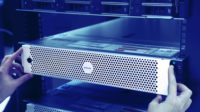You use a toaster for crisping bread; you wouldn’t use it for blending drinks nor would you heat an entire oven to crisp the bread. Similar to how a kitchen appliance is used to perform a specific task, a security appliance is used for a specific job. Using an appliance for video surveillance or access control applications has numerous benefits, such as saving money for end users by combining multiple components in one device, and enabling easier and faster programming for security integrators.
“The term appliance generally refers to a device that is dedicated to a single purpose, like a clothes dryer or microwave,” explains John L. Moss, chief product officer at LenelS2, Pittsford, N.Y. “Both [household and security] appliances have computers in them, but neither of them, for example, can operate Microsoft Word. When one appliance is connected to other appliances and/or to an internet cloud, we call it a network appliance. Network appliances usually offer a user interface that is accessible through a web browser and doesn’t require a user to install software on multiple computers.
“When we speak about a video appliance, we are talking about an appliance that has video-related software embedded in it. So, when a user plugs it in and turns it on, it only runs the video application. This is distinct, for example, from a copy of video management software that you install on a general purpose PC. Typically, appliances run on smaller computing platforms, use Linux or some other smaller operating system, and scale by adding additional appliances rather than bigger appliances.”
Mitch Mershon, business development manager for end-to-end solutions at Axis Communications, Chelmsford, Mass., explains that one of the benefits of consolidating devices inside one unit, as an appliance does, is reducing the amount of space it takes up. “An appliance is the consolidation of a server and PoE switch. This reduces the form factor needed within IT rack space and also allows an installation to be more aesthetic. Additionally, when appliances include embedded software from the manufacturer, the appliance has likely been validated according to the manufacturer’s specific requirements to run the system effectively,” he emphasizes.
Defining a Security Appliance
To further understand what an appliance is in the world of security, Jammy DeSousa, senior product manager, Security Products, Building Technologies & Solutions, at Milwaukee-based Johnson Controls, proposes looking at how the IT world defines it. “The basic concept is creating a purpose-built device with just enough operating system (OS), processes and services for its specific function,” he explains, adding that it’s the same concept in security, but just targeted for video or access control purposes.
Bosch emphasizes the ease of implementation of an appliance, “They can turn it on, and with a few very small configuration steps, they can have it up and running,” says Troy Wideman, regional marketing manager at the Fairport, N.Y.-based company.
That doesn’t necessarily mean appliances are plug-and-play; rather, it means the hardware and software/firmware have already been paired to function together for a specific purpose. “The hardware comes pre-installed with the application and OS and typically a specific image that hardens the device from a cybersecurity standpoint. This is usually the main building block or foundation in any access control or video management system,” says Jason Glover, vice president of sales at BCD International Inc., Buffalo Grove, Ill.
“The concept of an appliance in the video world has been around for a while, mostly through the concept of DVRs and NVRs,” explains Brandon Reich, founder and CEO of SecureBI, Louisville, Ky., a business and strategic advisory firm specializing in the physical security and IoT industry. “Usually these devices are pretty locked down, meaning the user can’t make a whole lot of changes to it.”
Security Appliances: What They Do & How to Select Them
Listen Now: We speak with industry experts from Genetec, AMAG Technology and Bosch to learn more about what a security appliance is, and how it fits into the overall system.
Tom Galvin, founder and chief product officer, Razberi Technologies, Dallas, details the various functions that can be performed by an appliance and, hence, the many components that just one appliance can potentially take the place of. “Video appliances can include a range of functions, including a server, storage, Power over Ethernet (PoE) for cameras and other devices, managed Ethernet switches, cybersecurity and health monitoring software. The appliance also either embeds or supports the installation of video management software (VMS) and access control software. A complete surveillance system includes the video appliance, VMS, a network of IP cameras and Ethernet switches if they aren’t already embedded into the video appliance. Live and recorded video viewing can occur on the appliance itself or more typically from a separate laptop or mobile device.”
Mike Koponen, senior director, product marketing and strategic alliances, Pivot3, Austin, Texas, further elaborates: “Appliances can support the capture/recording of video; they can analyze the video (think video analytics); they can visualize the video (think appliances for a security operating center); or do a multitude of security applications such as access control, intrusion detection, physical security information management (PSIM) and other specialized appliances purpose-built for a specific task,” he says.
“A video appliance is a purpose-built solution with a specific intended application,” says Ronald Vantassel, business development representative at Arrow Electronics, Syracuse, N.Y. “The application could be video management, video recording, client viewing, analytics (license plate or facial recognition) and may come with software preloaded for this specific application or could be a hardware solution designed to integrate with software platforms.”
How to Select Today’s Appliances
One current trend in appliances is adding more capabilities to products. For example, an appliance that yesterday was designed strictly for video recording today might have analytics built in, or badging if it’s an access control appliance. It also could be a unified device that supports multiple functions and uses cloud technology.
The inherent ability of appliances to offer a little bit of everything to the market and the fact that they are evolving to include greater functionality makes them hard to pin down. So, before making a final selection about which appliance you’re going to choose to resell to your customers, talk to the manufacturers about some of the following subjects.
The operating system. Does the appliance support Windows or Linux? “Some appliances utilize a Linux OS, some utilize Windows OS and some use a very specific OS with attributes that are associated with that VMS or access control software running on them,” Glover explains. “They are typically made up of a motherboard, disk drives, RAM and a series of connectivity options (Bluetooth, Wi-Fi, Ethernet, etc.) Most appliances are connected to the network through a standard Ethernet connection(s).”
It is important for security integrators to understand the pros and cons of the operating system because of their client’s preferences and policies. “If the integrator comes in to an end user that says, ‘Everything on our network must run Windows and must run this version of Windows,’ and they try to put in a Linux-based appliance on the network, they could actually get themselves in trouble. They need to be in touch with and aligned with the end users’ IT department or IT policies,” Reich says.
Lock-down: How “locked down” is the appliance? It’s a colloquial term, but one that many manufacturers use to describe the ability of their appliance to be managed, serviced, scaled and more. For example, Koponen asks, if multiple appliances are used, can they be managed as one unified system or do they behave as islands?
“One of the first things I would want to know is how locked down is that device, because that could impact things like scalability as well as manageability,” says Greg McDermott, manager of application engineering at AMAG Technology, Torrance, Calif. “For example, say this is an appliance that can only be serviced through the manufacturer, so . . . that could be a cause for concern because it becomes harder to service if you’re relying on one manufacturer to provide those services.”
Are security integrators able to replace parts themselves? Can they make configurations to the software or upgrade it as new software is introduced? How about maintenance; how will OS patches and firmware updates be performed?
Richard Goldsobel, vice president of the Continental Access division of Napco Security Technologies, Amityville, N.Y., cautions, however, “It becomes a double-edged sword: the more you make a dedicated piece of hardware generally expandable and multi-capable in terms of its functions you start to move that device more and more toward the same problems that you were trying to overcome within an embedded appliance, so you might need more of an operating system, more expansion of RAM or license capability to add features . . . But the more you try to move the appliance to the full server capabilities or PC type of capability you start to incur the maintenance, and the costs, and the problems . . . There are IT domain policies; there will be IT people asking about bandwidth and what’s this going to do to their network, and what virus protection do they need, and all of those things — where an appliance being a very locked down device cannot have the requirement for those problems or those issues. So IT people can feel much better about putting an appliance on their network once they understand what the issues are for that appliance.”
Cybersecurity: The reason cybersecurity is so important is because many security appliances do not run on standard Windows-based operating systems, Reich says, where Microsoft would be performing OS updates and applying security patches.
Laurent Villeneuve, product marketing manager for video and appliances at Montreal-based Genetec, whose appliances are Windows-based, has this advice: “Ask the questions like, ‘Are you doing the hardening for us? Are you checking if it fits with the Windows environment? Do you have endpoint protection installed on the appliance?’ All these things that should be done by the manufacturer, because they’re the closest to the machine and the software.”
Open architecture & integrations: Is the appliance open and can it support third-party software for things like video management and analytics?
“A lot of companies will talk about having an open architecture but when you look closely, it’s not truly open architecture,” says Despina Stamatelos, product marketing manager, access control, Genetec. “I would get the details on what, how many, or who those third-party devices are and how those integrations work. Oftentimes they may need a very high-level integration, as well as how often do they provide updates? We’re upgrading the software that goes down to our devices three to four times a year.”
Goldsobel adds, “As appliances have also struggled to add options and functionality and be a wider enterprise option, the whole embedded, dedicated hardware has also changed. Appliances now are truly very wide ranging, from some very fixed Linux devices all the way up to full Windows devices in small footprints.”




